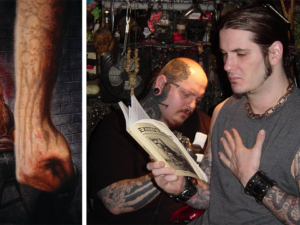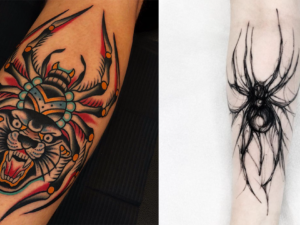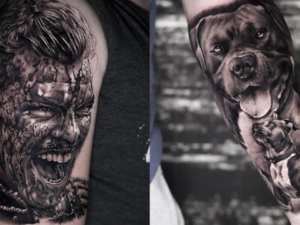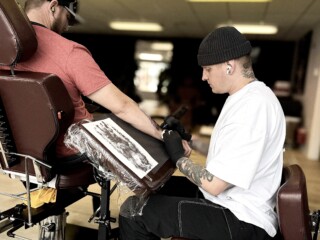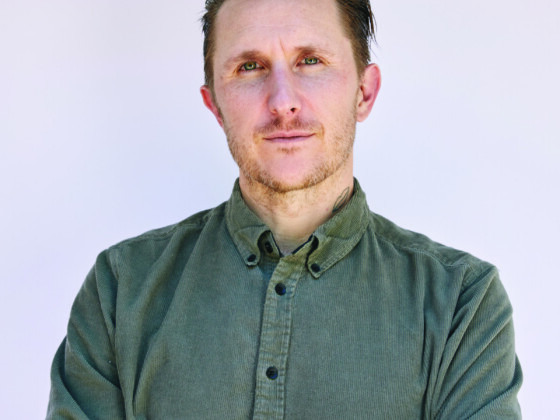Inked Mag
December 14th, 2018
Igorot Headhunter Tattoos
A Journey into the Spirit World
Article by Bill Waytowich
The Igorot people inhibit the mountainous area of the northern Philippines, a region known as the Cordillera . They have a rich tradition of having beautiful, intricate anthropomorphic and geometric tattoos. Both women and men have these tattoos, primarily on the arms and chest region. They were considered a serious religious experience while enduring hours of pain to attain the badge of honor. Tattooing was also considered a sign of rank and power in the Igorot community. These tattoos could only be earned by accomplishing a specific task, or as a rite of passage.

Men had tattoos on their chests and heads primarily as signs of their strength as warriors. Tattoos that were specific to women of the tribe depict detailed lines on their arms and wrists, or full chest and arm tattoos, which were indicative of the mountain tribes and seen more as marks of beauty. It is customary for boys under 10 years of age to be tattooed. Their first tattoos are usually a small, half-inch cross on the cheek or perhaps a line or small cross on the nose region.

The styles vary depending on the region and tribe that the person came from. The Igorot are a combination of different tribes depending on actual geographical location in the Philippines. So the name Igorot is more of a collective term used to describe six different ethnic groups: the Apayao, Bontoc, Ibaloi, Ifugao, Kalinga, and the Kankanaey.
Igorot Headhunter Tattoos
Tattoos worn by the Bontoc Igorot men symbolized the number of human heads taken during a headhunting raid.
The chaklag tattoo, usually a design going upward from each nipple, and curving outward onto the shoulder and region of the upper arms, symbolizes the number of fresh trophy heads taken during inter-tribal raids and battles.

The Kalinga Igorot would tattoo their warriors on the back of the hands and wrist after their first kill. The designs and placement would get more elaborate depending on the number of trophy heads they acquired. An Igorot warrior would not be permitted to get married until he took his first trophy head.
Most tattoos would be accompanied by some sort of ceremony depending on the accomplishment which would effectively activate its spiritual and magical powers. Every tribe had an assigned tattoo artist who perfected his craft after every tattoo administered. Tattooing handles and needles were usually made from wood and animal horn. The tattoo was applied by tapping the needle which was attached to a wood handle with a wooden mallet. The tattoo ink was a mixture of tree resin and soot which was rubbed into the wound as the tattoo was applied. The finished tattoo would be dull and blackish-blue in color, sometimes having a green color cast. In some cases the area would become infected. This method of tattoo is very common amongst most primitive tribes.

While many tattoos were for a certain accomplishment such as a fresh head taken, or possibly attaining the highest rank of chief, some tattoos were given for medicinal reasons as well. A small tattoo would be placed on the exact spot of illness such as a tumor or wounded area for therapeutic healing. Medicinal tattoos have been a practice that spans back thousands of years.
An example of this is Ötzi the Iceman who was discovered on the Italian-Austrian mountain border in 1991. Ötzi had several tattooed markings, and he was carbon-dated at around 5,200 years old. The Iceman had some interesting tattoos placed around several areas of his body that are strikingly similar to acupuncture marks which could be evidence of early tattooing as a medicinal or therapeutic means. If this is correct, and Ötzi’s tribe was practicing Chinese medicine, then acupuncture had been in use in Europe 2000 years earlier than previously thought.

Igorot Warfare
An inter-tribal battle usually starts after a tribesman takes the head of a member of a rival tribe. This trophy head was a rite of passage ticket right into manhood. A raid can also be initiated by a tribesman who intends to marry. The offended tribe can do a number of things to alleviate the situation. They can go right to war if unhappy about the situation, or pursue peace by sending tribal leaders to negotiate compensation for the other tribe’s loss. Or if no agreement is made, then all-out war would ensue. At this time all the men from both sides would participate in the heated battle. They would initially appear at the border shouting insults at each other. Peace is still possible at this juncture if one side decides to give up rather than fight. At this point, an envoy is sent to the other camp with a peace offering such as a pig or two. Friendship is eventually restored if the gift is accepted. Otherwise war between the two tribes is imminent.

At the outbreak, the men go to war with a wooden shield, battle-ax, and three spears. The battle rages on, sometimes retreating before advancing again. Spears can be thrown as far as 29 feet. When the battle closes in the warriors would then use their battle-axes and shields mostly for close combat. The battle-axes have a sharp blade edge on one end for slicing, and a sharp, pointed end used primarily to puncture. Sometimes when all weapons have been exhausted, rocks will be thrown as a weapon until the enemy is wounded. Later on in Igorot history, when guns were introduced to the tribe, the death toll was far higher during warfare.

Battles sometimes were fast and furious, or lasted a whole day with 20 or more heads taken. Most heads of enemies were cut off with a battle-ax even before the wounded man was deceased. The head was then washed in the river by holding onto the hair. The lower jaw was cut from the head before being boiled to remove all the flesh. The jaw later becomes a handle for the victor’s gangsa, which is a ceremonial metal drum. Then an elaborate ceremony would take place, and the victorious warrior would finally be entitled to a head-taking tattoo.

Headhunting for the Igorot was for religious purposes and the acquisition of magical powers. Also to ensure abundant harvests, increase prosperity, and to ensure the fertility of the tribe.
Spirits and Religion
The basis of Igorot religion is a belief in the spirit world—animism is found widespread among most primitive tribes. The Igorot believed in the Anito, or spirit of the dead, which governs all dead people, and has all power for good, evil, life, and death.

During his or her life, an Igorot person has a spirit called “tako,’’ which is the soul of a living native that tends to leave the body sometimes to bring the person knowledge of the spirit world through dreams and visions. After death the spirit receives a new name, and it goes about in a body that is invisible to the eye of man yet unchanged in appearance from that of the living person. In this world of spirits the Igorot is born. He constantly seeks to appease spirits until he surrenders to the more-than-matchful spirits, whose numbers he joins, and powers he acquires.
Limum is the name of the spiritual form of the human body. Limum is seen at times in the pueblo and frequently enters habitations, but it is said to never cause any harm. Limum may best be translated by the English term “ghost,’’ but does not have the negative connotation.

When an Anito dies, or changes its form, it may become a serpent. The Igorot never kill snakes for this reason, except if it bothers about their dwelling. In many respects the dreamer has seen the Anito world in great detail through dreams. He has seen that the Anito are rich and poor, old and young, and seen them through birth, marriage, old age, and death. Each man seems to know in what part of the mountains his Anito will dwell, because sometimes one of his ancestors is known to inhabit a particular place, and the children will go to be with them.
All injuries, diseases, and deaths are believed to be caused directly by the Anito. In certain ceremonies the ancestral Anito are urged to care for living descendants, to protect them from Anito that seek to harm. Children are named often after their ancestors. This way they receive extra protection from them.
The Pinteng is specifically responsible for the death of every person who is a victim of head-taking. Pinteng puts murder in the minds of all men who are to be successful in headhunting. He also sees the atrocities of warfare, and brings justice to those who kill younger tribal members, which is highly forbidden.

World War II and General Douglas MacArthur
During colonial times, some Igorot mountain tribes resisted foreign invaders and were never fully conquered, similar to the Jivaro of South America. As headhunters they were feared by their enemies for ferocity in battle and the staunch defense of their lands.
Until the era when the United States occupied the Philippines after the Spaniards, most of the Igorot territories remained free of foreign invaders. The Igorots were amazingly the last to be conquered after many bloody battles.
During WWII, the Igorot had witnessed so many atrocities committed against them in the Philippines that they decided to join the war against the Japanese invaders. Although it was outlawed, many Igorot warriors occasionally took the trophy heads of Japanese soldiers, arguably lapsing back a bit into the prior tradition of headhunting. They gained the respect of their American allies and struck fear into the Japanese soldiers.

General MacArthur was very impressed by the fighting prowess of the tribe. His weary troops were facing imminent demise from the overwhelming Japanese onslaught, and he welcomed the help of the indigenous Igorot warriors. The Igorot chopped away at the entangling foliage, clearing a path and also serving as lookout for American tank crews.
When the harsh attack was over, the remnants of the tanks, and Igorots, were still there, but the 20th Japanese Infantry Regiment was completely destroyed. General MacArthur had many kind words for the Igorot people for their brave and gallant efforts in fighting off invading Japanese forces.
Igorot Life Today
Times are likely difficult for the Igorot, having to shed many headhunting beliefs after being entrenched in their blood for so many years. It has been said that the last trophy heads cut off by Igorot headhunters were in the late ’70s. Today’s headhunting ritual continues with a wooden substitute for a human head, attempting to achieve the same benefits of power, wealth, plentiful harvest, and fertility without the violence of the past.

Like most other tribes that still exist today, the Igorot are becoming more modernized, and in turn are facing the challenges of a modern world. The Philippines has a rich eco-system which is under attack from development such as deforestation by loggers. The Igorot people themselves also farm using slash-and-burn cultivation techniques. The Philippines is one of Asia’s fastest-growing economies.
While the Igorot of the past have had a reputation of being fierce jungle headhunters, today they are mostly a docile, peaceful society, consisting of close-knit families who are still extremely engulfed in the Igorot tradition. Even a beautiful, remote tropical island paradise like the Philippines can’t escape the persistent problems that plague most primitive cultures.
Editor's Picks
Paul Booth Illustrates Cover for Pantera Graphic Novel
The revered tattoo artist created a cover for a graphic novel celebrating the 30th anniversary of “Vulgar Display of Power”
Scary Spider Tattoos
Spiders are terrifying, yet for some reason people sure do love to get tattoos of them


